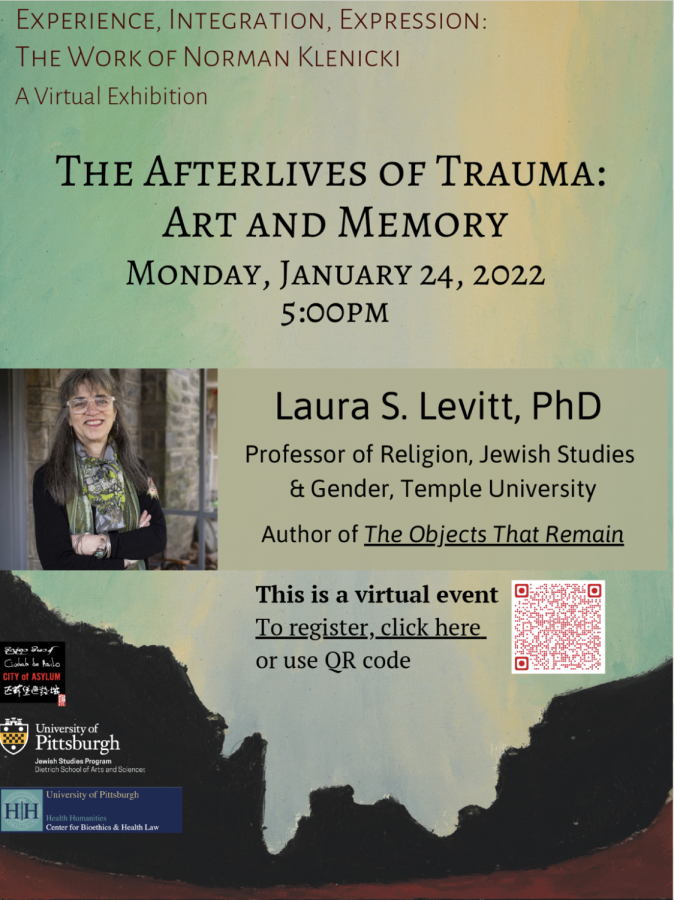Levitt presents ‘Afterlives of Trauma’ lecture, opens for online Klenicki exhibit
Guest speaker Laura Levitt discussed the relationship between art, trauma and healing while presenting her lecture, “The Afterlives of Trauma: Art and Memory.”
January 26, 2022
Artists and writers can create for many reasons, whether it be self-expression, a big project or just for fun. Creating art and literature can also serve a more serious purpose as well — coping with trauma.
Presenting her lecture “The Afterlives of Trauma: Art and Memory,” guest speaker Dr. Laura Levitt discussed this relationship between art, trauma and healing.
Co-sponsored by City of Asylum and Pitt’s Jewish Studies program, the lecture served as an opening discussion for the Center for Bioethics and Health Law’s new virtual exhibit, “Experience, Integration, Expression: The Work of Norman Klenicki.”
The exhibit focuses on the work of Klenicki, a self-taught Brooklyn painter. It reflects on Klenicki’s life and work through themes such as mental health and the effects of medication, as well as the artist’s personal experience and the enduring memory of the Holocaust.
Levitt, a professor of religion, Jewish studies and gender at Temple University, discussed Klenicki’s work and its relation to personal and generational trauma, specifically the trauma faced by Holocaust survivors and their families.
Levitt displayed a series of Klenicki’s works at the start of her lecture, commenting on their relation to trauma from the Holocaust. According to Levitt, artwork is an immensely powerful way to understand emotions that may spring from traumatic experiences.
“[Klenicki’s] work gives the opportunity to consider the lingering effects of trauma, how we carry on, how we live with and continue to build lives,” Levitt said. “Art helps us feel — it helps us open up to unexpected connections and distinctions, things we have not already thought or felt.”
Building off of her 2020 book, “The Objects that Remain,” Levitt discussed how objects and artifacts help us deal with trauma, violence and loss. She also discussed how she has worked through her personal experiences by relating to the experiences of others, such as Klenicki.
“My story is connected to the story of others,” Levitt said. “I write about my rape, but do so in relation to other stories of violation, trauma and loss. I insist on these connections to discover what placing different legacies next to each other can enable us to see and to feel.”
For Levitt, writing books and producing other forms of artwork is a form of self-reflection that can sometimes create a feeling of losing something, but ends up producing new connections with others once finished.
“I think that in the process of creating, the more you do it, the deeper your own understanding emerges,” Levitt said. “Part of putting the work out into the world is a loss because they’re kind of our special companions, but we end up opening a new space for a different kind of connection.”
Bridget Keown, the exhibit curator and lecturer in Pitt’s gender, sexuality and women’s studies program, echoed Levitt’s sentiment that the exhibit and artwork as a whole is a powerful tool for self-reflection.
“What’s really powerful about this exhibit is the way it invites viewers to bring themselves and their stories to these paintings,” Keown said. “But it is also a way in which these very personal experiences can be used to build empathy among viewers and help people think through their own stories.”
Levitt also discussed the importance of honoring ancestors’ traumas through storytelling and active listening.
“Listen — really listen. And don’t feel like you have to get it all down,” Levitt said. “And if you go to a place like the Holocaust Museum, you may see things that may not be visible to me, or to even some of your classmates, but you do us an honor by telling us what you see, feel and experience.”
Lisa Parker, the director of the Center for Bioethics and Health Law, said the center studies the relationship between the health humanities and arts, and how they help to inform our understanding of health. Levitt’s discussion is the first of a series of programs that relate to the exhibit.
“To help launch or to draw attention to the exhibition, we want to have a series of programs that interact with different aspects of the exhibits,” Parker said. “It includes mental health, Holocaust trauma, disability and antisemitism — so we plan to have programming that relates to that.”
The next lecture in this series will take place on Feb. 28. For Keown, who has curated the exhibit for the past two years, Levitt was the perfect person to open for this exhibition.
“Dr. Levitt’s work is very much focused on issues of art and identity, and how the objects we create and curate help us better understand ourselves and society and kind of make sense of things that feel nonsensical,” Keown said.
Levitt acknowledged trauma never truly leaves us, but art is a compelling tool to help us make sense of it.
“Art and writing are acts of imagination that enable many of us to carry on,” Levitt said. “They enable us to tell stories and show how we feel, and they make it possible for us to converse with others, provide companionship and combat the loneliness of living with such memories.”



